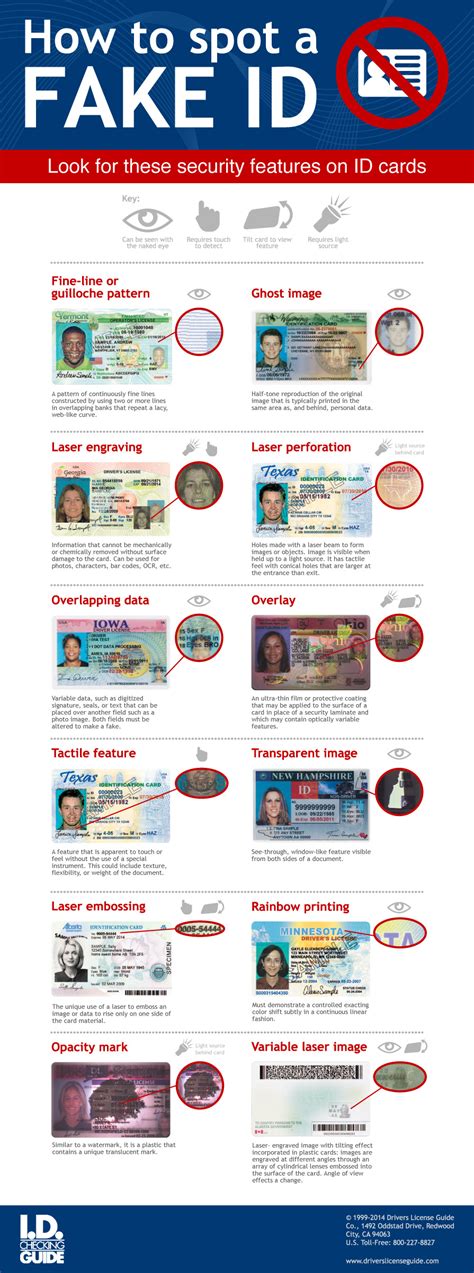Fake IDs are a serious problem in the United States. According to the Department of Homeland Security, over 1 million fake IDs are seized each year. These IDs are often used by underage people to purchase alcohol, tobacco, and firearms. They can also be used by criminals to commit identity theft and other crimes.

It is important to be able to spot fake IDs in order to protect yourself and your community. Here are some tips on how to do it:
Check the ID for the following:
- Holograms: Real IDs have holograms that are difficult to counterfeit. Look for a hologram that is clear and well-defined.
- Microprinting: Real IDs have microprinting that is too small to read with the naked eye. Use a magnifying glass to look for microprinting on the ID.
- Watermarks: Real IDs have watermarks that are visible when the ID is held up to the light. Look for a watermark that is clear and well-defined.
- Raised lettering: Real IDs have raised lettering that is difficult to counterfeit. Feel the lettering on the ID to make sure that it is raised.
- UV markings: Real IDs have UV markings that are visible when the ID is held under a black light. Look for UV markings that are clear and well-defined.
Compare the ID to the person presenting it.
The person presenting the ID should look like the person in the photo. If the person does not look like the person in the photo, the ID is likely fake.
Ask the person presenting the ID questions about it.
Ask the person presenting the ID questions about it, such as where they got it and when it was issued. If the person cannot answer the questions, the ID is likely fake.
If you suspect that an ID is fake, report it to the authorities.
If you suspect that an ID is fake, report it to the authorities. You can do this by calling the police or by contacting the Department of Homeland Security.
Table 1: Common Signs of a Fake ID
| Feature | Real ID | Fake ID |
|---|---|---|
| Holograms | Clear and well-defined | Blurry or poorly defined |
| Microprinting | Too small to read with the naked eye | Can be read with the naked eye |
| Watermarks | Clear and well-defined | Blurry or poorly defined |
| Raised lettering | Difficult to counterfeit | Easy to counterfeit |
| UV markings | Clear and well-defined | Blurry or poorly defined |
Table 2: How to Compare the ID to the Person Presenting It
| Feature | Real ID | Fake ID |
|---|---|---|
| Photo | Matches the person presenting it | Does not match the person presenting it |
| Age | Matches the age of the person presenting it | Does not match the age of the person presenting it |
| Gender | Matches the gender of the person presenting it | Does not match the gender of the person presenting it |
| Height | Matches the height of the person presenting it | Does not match the height of the person presenting it |
| Weight | Matches the weight of the person presenting it | Does not match the weight of the person presenting it |
Table 3: Questions to Ask the Person Presenting the ID
| Question | Real ID | Fake ID |
|---|---|---|
| Where did you get this ID? | Can provide a legitimate source | Cannot provide a legitimate source |
| When was this ID issued? | Can provide the date of issuance | Cannot provide the date of issuance |
| Why are you presenting this ID? | Can provide a legitimate reason | Cannot provide a legitimate reason |
Table 4: How to Report a Fake ID
| Method | Contact information |
|---|---|
| Police | Call your local police department |
| Department of Homeland Security | Visit the DHS website or call 1-800-225-5324 |
Conclusion
Fake IDs are a serious problem, but they can be spotted by following the tips in this article. By being aware of the signs of a fake ID and by asking the person presenting the ID questions about it, you can help to protect yourself and your community from identity theft and other crimes.
